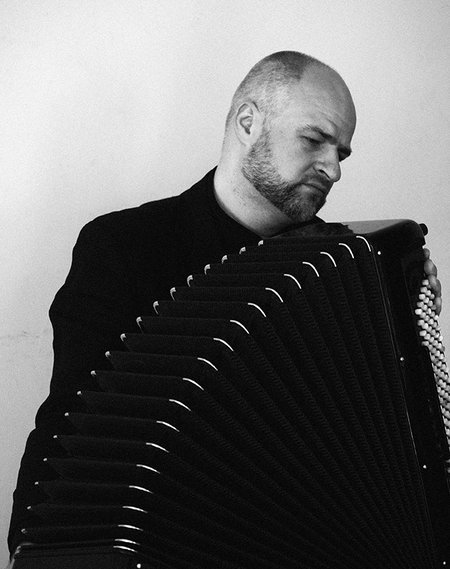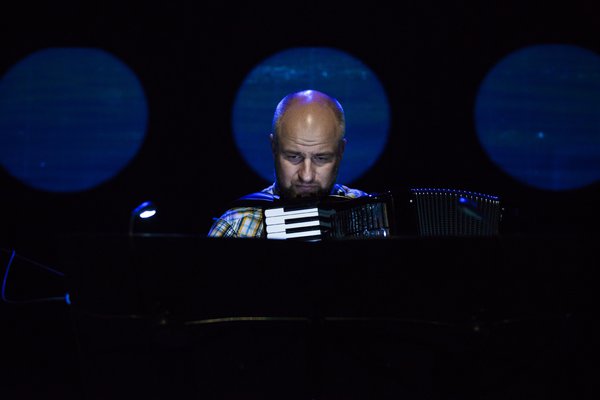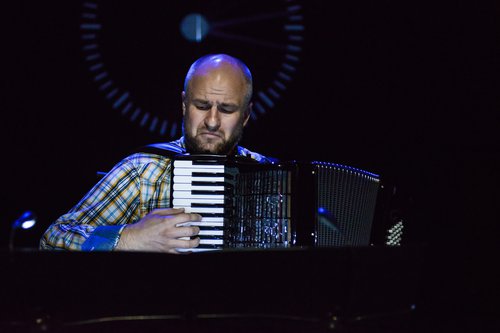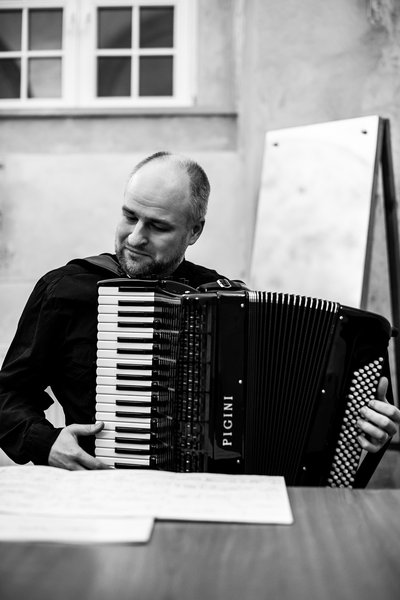Andrius MASLEKOVAS, Lina NAVICKAITĖ-MARTINELLI | ContemporACCO and Other Acco Projects by Raimondas Sviackevičius
Few other instruments match the accordion in terms of their constraint by entrenched stereotypes even though the image of the accordion has been changing over the years – slowly and perhaps somewhat reluctantly. This is why the musicians who tirelessly challenge the preconceived notions through their artistic work deserve particular acclaim. One of them is the accordionist Raimondas Sviackevičius, an artist of wide horizons without whom the scene of contemporary music in Lithuania is inconceivable. With dedication and a clear objective in mind, he has been shaping the image of the accordion as an instrument of new academic music as his programmes boldly cross the established boundaries of musical genres and repertoires.
The mission undertaken by the performer might seem almost bizarre at the first glance since the accordion, which was invented in the nineteenth century, should be considered more appropriate for modern music as compared to any other standard orchestra instruments that come with deep-rooted traditions of performance, their timbres associated to scores of rhetorical figures and story-telling imagery. Moreover, even though all the traditional instruments of the symphony orchestra, just like the accordion itself, entered professional music from folklore and have been widely used to perform popular music, the orchestra instruments, contrary to the accordion, enjoy their ‘classical’ status exactly due to the established traditions of performance and their sonic connotations. Oddly enough, despite its relentless search for new forms of expression and its striving to distance itself from conventional notions modern music has clearly been dominated by classical instruments so heavily laden with tradition. The use of other instruments that are newer in the historical sense, more open for novel findings and offer vast potential of expression has been sporadic and sometimes even socially unacceptable, especially in Lithuania.
It is precisely this ‘odd’ issue and its possible solutions that Raimondas Sviackevičius has dedicated his entire professional career to. In addition to the fact that his concert repertoire consists solely of new music, he has been an initiator and first performer of a large number of solo, chamber, electro-acoustic and symphonic pieces for accordion. In that role, he has been working together with many Lithuanian composers to forge a creative cooperation that has been yielding ever more abundant and significant results. It is no coincidence that in the new music scene in Lithuania Sviackevičius’ name has long been evoking associations with quality, high artistic standards and a specific ‘avant-garde’ musical aesthetic, even though the latter might sound rather bizarre given the context of the 21st century.
For several years, he has been involved in what might be seen as a new trend in his artistic career, namely, the launching of different projects the titles of which all bear his trademark, the elements of the word “accordion.” The projects include acCORPUS simulacrum, a compact disc of chamber music for accordion by Lithuanian composers, his recital ACCOntempoRED, the ACCOsax trio and many others. Such a brand might evoke different associations, yet one of the many ways of interpreting it is Raimondas’ wish to depersonalize himself in order to attribute his personal traits to the instrument rather than to a particular performer. This may effectively mark a new step in shaping the role of the accordion as an instrument of modern music in Lithuania. Acco is a word-bit that is simple and universally understandable and, at the same time, the trademark that bears new qualitative meanings and is capable of expanding in every possible direction but eventually becomes almost independent from its creator’s personality. Currently, it is as if synonymous to all the aficionados of modern music, balancing between the academic and experimental genres.
The accordion ensemble ContemporACCO is just one of the acco projects launched by Sviackevičius, yet it is unique in at least several aspects. Firstly, the number of performers has never been fixed thus the ensemble may include from two to eleven accordionists; this versatility enables it to perform vastly different pieces. The ensemble thus opts for a repertoire requiring a different number of musicians and transforms itself according to the requirements of compositions instead of adapting them to its own capabilities. Secondly, ContemporACCO’s repertoire mostly consists of original pieces; this is the feature that distances the group from other accordion ensembles which tend to play arranged and transcribed music. (It is no secret that the choice of original music for accordion ensembles is rather limited; this is why ContemporACCO encourages composers to write new pieces.)
The involvement of the young members of the ensemble, all of whom are students or recent graduates of the Lithuanian Academy of Music and Theatre, in the mechanism of the birth of new music and the encouragement of creative progress among Lithuanian composers is a particularly significant achievement within the local community of modern music. Every young group that is open to discoveries and challenges, especially bearing in mind its unique ability to transform in size, opens up broad alternatives for creative breakthroughs that are potentially capable of becoming historically important milestones in Lithuanian music (here one may recall Iminas Kučinskas and the phenomenon of his electronic cello in the 1970s). On the other hand, unconventionally staffed ensembles attract particular interest abroad.
Composer Andrius Maslekovas and musicologist Lina Navickaitė-Martinelli speak with Raimondas Sviackevičius about the new accordion music by Lithuanian composers, ContemporACCO and his other acco projects.
Would you please say a few words about the acco projects you have launched? What was the main idea behind that brand if we may call it so? Has it acquired new meanings over time?
It is you who have decided acco is a brand. Whatever you call it, the idea encoded in the name is much more important – the idea of allowing the accordion a more ‘solid’ status by singling out acco in the titles of my projects. I would not dare to judge whether that is a marketing stunt or rather a play of symbols, yet what I wanted was to present the art of the accordion to the public by identifying the instrument rather than a performer (which is a conventional method) and, at the same time, to send a message to potential listeners in order to intrigue them and to raise a question that each of them could answer individually.
Each of the acco projects you have mentioned, as well as the others, has its own history. ACCOsax Freeminded, the project based on free improvisation and elements of contemporary eclectic music, was born out of my work with Janas Maksimovičius, a saxophonist and one of my best friends. The percussionist Arkadijus Gotesmanas joined later, and the trio under that name has been active since 2003. ACCOntempoRED came to life in St Catherine’s Church in Vilnius in 2007. The project involved a large number of instrumentalists and a female singer. We employed electronics, pre-recorded music and original new music which we synthesized with live spontaneous improvisations. The concert culminated with a joint experiment of all participants, a spontaneous contact-based improvisation.
acCORPUSsimulacrum, the title of the compact disc released in 2009, bears several codes including acco (accordion), corpus (body) and simulacrum (in this particular case the word refers to the timbral quality characteristic to all instruments recorded on this CD; on the global scale, however, the word lifts the accordion to the level of importance of other academic classic instruments). Usually the titles embrace several meanings and codes but I rarely decipher them because I think leaving the task for the listeners is much more entertaining.
How did you come about the idea of setting up ContemporACCO?
I guess many performers who are not indifferent to contemporary music think of bringing together an ensemble to perform it. Our ensemble is nimble in many senses therefore it can help realize contemporary ideas by doing the job that is appropriate, exciting and, most importantly, worthwhile. Bearing in mind the lack of new original repertoire for accordion, the creation of the ensemble looks natural, just like our initiatives aimed at encouraging composers to write music for us. Since the very first days, we have been a project-based ensemble which prepares programmes of modern music for very concrete performances. We often play together with other instruments, singers and electronic music. Certainly, the ensemble of accordionists as such is no novelty, although a mobile group of accordions focussed exclusively on performing contemporary music is a new phenomenon in Lithuania. Its birth was partly encouraged by two musical events in 2013: Druskomanija, the festival of new music in Druskininkai, where we played pieces by Osvaldas Balakauskas, Vykintas Baltakas, Vidmantas Bartulis, Bronius Kutavičius, Žibuoklė Martinaitytė and other composers, and the XVI International Accordion Festival or, more specifically, its project ACCOpremjeros (ACCOpremieres). The latter event was a joint concert featuring young composers and performers who presented their pieces written specially for that performance, including Žaliasis spengesys (The Green Tingle) for ten accordions by Ramūnas Motiekaitis, Ponich by Lukrecija Petkutė, Sakura-no-hana by Dominykas Digimas, Mato sprintas arba nesėkmės chromatinėje gamoje (Matas’ Sprint or Failures in the Chromatic Scale) by Monika Sokaitė, Chromatografija (Chromatography) by Raimonda Žiūkaitė, Herojus Miško Žiemą (Hero of Forest in Winter) by Andrius Šiurys, and other compositions for accordions, pianos, wind instruments and vocals some of which involved special effects and prepared instruments.
Since ContemporACCO is a group in its early stages of activity, it is apparently too soon to speak of its creative maturity. Nevertheless, the ensemble has already reached a rather high artistic level.
The quality and end-result of every collective effort depends on preparedness, worldview and musical apprehension of each individual member. Lithuanian accordionists play modern pieces already during their years of study and become familiar with the accordion repertoire in foreign countries while preparing for their own solo performances. They find it interesting and attractive to be a part of the ensemble which plays contemporary music, hence all of them do it with pleasure. It is up to our colleagues and to composers to judge about our artistic level. The truth is, however, that mobile experimental groups like ours are extremely valuable to individual instrumentalists both in terms of their musical and technical advance and because of their ability to communicate and find solutions whenever they encounter different, often very unexpected, issues. We strive for perfection together.
Accordion music has gained considerable popularity in Lithuania over recent years, however one must emphasize the fact that ContemporACCO and all other acco projects are based on an entirely different propagation methodology compared to the relatively powerful ‘mainstream’ trend which regards the instrument in a rather traditional manner. Do you think similar results could be achieved by playing contemporary music only? Or perhaps you eye a different target audience in your work?
As a matter of fact, the accordion has played a key role in popular music for an entire century already, be it folk-style tunes or pop songs where it acts as an accompaniment. One has to understand that contemporary and experimental music and the ability to ‘read’ it will always remain the area for a specific and rather limited circle of people, the field that has no ambitions of gaining any significant popularity. (I would actually avoid using the word ‘popularity’ when speaking of ContemporACCO at all.)
The work with young composers involves the commissioning of new pieces and getting the composers acquainted with the instrument that is new for them. What is this process like? Do the composers find it difficult to make the instrument their own?
One of the key objectives of the ensemble is to display the accordion’s potential to composers by giving them a chance to explore the previously undiscovered instrument. Our cooperation is based on live demonstrations of the instrument, its effects and unconventional methods of producing sound that might be useful in contemporary music. We often suggest the most convenient solutions in a particular situation as well as effects and appropriate diapasons; we discuss the balance of musical material to be played by each hand, the issues of articulation within the given texture and so on. I have to admit that composers who write pieces for one or more accordions for the first time often come up with solutions that are impossible to implement or that become almost imperceptible during eventual performance; that is why composers must work together with accordionists.
Our concert programmes usually include pieces by Lithuanian and foreign composers selected according to the principle of contrast because we want to expose the capabilities of the accordion at its best. We also play rearranged versions of the compositions originally written for other instruments and different ensembles. We adapt them, by ourselves or together with composers, to be performed by an optimal number of accordions. Among such pieces are Ant balto popieriaus (On White Paper) for flute, clarinet in B and accordion by Rita Mačiliūnaitė, Čiauškanti mašina (Prattling Machine) for four accordions by Rytis Mažulis, and Merz-machine for eight accordions and recording by Šarūnas Nakas.
In general, what can you say about the way contemporary composers treat the accordion? Have you noticed any regularities as to which features of the instrument they are particularly fond of?
What attracts them most is the accordion’s unconventional nuances rather than its typical features. They are interested in the high piccolo register which is sometimes reminiscent of ‘screaming’ electronic sounds. They like extremely low sounds and non-tempered glissandos that render the out-of-tune effect; they also like ricochets, bellow tremolos, different vibratos and percussion effects. Composers are usually eager to employ the unconventional capabilities of the accordion immediately after they first hear them. Naturally, they often risk overloading the piece with the effects and therefore to ‘devalue’ it. As I have already mentioned, many of them use the accordion merely as a source of a specific colour while others long for those traditional ‘nice’ tunes. Together with the Gaida Ensemble, we once played Madame Butterfly, Madame Bovary by Algirdas Martinaitis (2004), a piece which, according to the composer, required the flavour of the ‘real’ French accordion. Yet, my concert instrument does not even offer that kind of the ‘out-of-tune’ timbre…
As a solo performer, you have also been asking Lithuanian composers to write more for accordion. Many of them composed and dedicated music to you. Would you name the most helpful composers in regard with your initiative?
Shortly after finishing my studies I went to see a number of composers and asked them to write me some music, just like that; I was very naive then because I did not know the way music should be commissioned. Nevertheless, there is one piece from that period, Atsisveikinimas su ginklais (A Farewell to Arms) by Nomeda Valančiūtė who decided to help me and wrote it without any remuneration. The premiere took place in 2001 in Holland. A Farewell to Arms is also the title of my first solo album released in 2004.
The same year I joined the Gaida Ensemble which travelled a lot and played chamber music by Baltakas, Martinaitytė, Merkelys, Šenderovas and Tamulionis featuring the accordion. I worked closely with Žibuoklė Martinaitytė when she was writing Driving Force, the piece we first performed with trombonist Mike Svoboda and saxophonist Liudas Mockūnas in 2004. She was remarkably interested in the textures the accordion offers and the effects the instrument is able to generate; I gave her plenty of accordion music in the form of recordings and on paper. It is no coincidence then that, commissioned by the International Accordion Festival in 2006, she wrote Proveržis (Breakthrough) for accordion and chamber orchestra, the first Lithuanian concerto for accordion and orchestra.In 2007 I took an extra step by commissioning a piece for accordion and symphony orchestra, the task was willingly undertaken by Feliksas Bajoras. His deep-digging attitude towards the creative process is simply unique. I cannot think of many composers who work like him. As a performer, I got plenty of experience and, on the other hand, faced considerable challenges because the piece proved to be difficult to learn due to its complicated musical material and sometimes inconvenient textures. I have to say though that the composer treated the accordion in a rather conservative manner, perhaps because of his music’s immanent folklorism that limits his ability to hear the instrument differently. He was not really interested in the ways other composers regarded the accordion nowadays because he heard everything his own way. Despite that his Promise, a concerto for accordion and symphony orchestra, is an excellent and in many ways outstanding piece that can, in my opinion, become part of the international repertoire.
Lithuanian composers later wrote more music for accordion and orchestra, such as Elegija Tėvynę palikusiems (Elegy for Those Who Left the Homeland) for accordion and strings by Giedrius Kuprevičius (2009), Accordion Concerto with chamber orchestra by Arvydas Malcys (2010), the remake of the chamber piece Evakuacija (Evacuation) by Remigijus Merkelys for solo accordion and string orchestra (2010) and as many as three versions of Dovydo giesmė (David’s Song) by Anatolijus Šenderovas one of which is to be performed with a chamber orchestra.
Is chamber music still one of the most important areas for the composers who choose the accordion as their means of expression?
Lithuanian composers have written several pieces for solo accordion recently, including Lento by Ramūnas Motiekaitis (2013), Mozaika (Mosaic) by Osvaldas Balakauskas (2013–14), Akmenų siuita (The Suite of Stones) by Vytautas Germanavičius (2014) and TePra by Diana Čemerytė the first performance of which is due December 2015. Despite that, most of the premieres and commissions undoubtedly represent chamber genres. What is important is the fact that composers tend to bring together the accordion and other instruments as equal partners in whatever combinations they offer. We commissioned and performed Ako-07 for solo accordion and a large chamber orchestra by Jurgis Juozapaitis in 2007 together with the Nepaklusnieji Ensemble as part of the Musical Autumn Festival in Vilnius. We often get together with Mindaugas Bačkus, the cellist who played with us a number of chamber pieces by Lithuanian composers and recorded several of them, including Aria by Justė Janulytė, Sapnų pėdsakais (In the Footsteps of Dreams) by Arvydas Malcys, and Rhythmus Arhythmus by Bronius Kutavičius (all written in 2008). Artistic cooperation with the Chordos Quartet yielded in 2008 a full programme of music for accordion and string quartet, including Arkada (Arcade) by Teisutis Makačinas, Juodi šešėliai – balti šešėliai (Black Shadows, White Shadows) by Vytautas Germanavičius, Nežinios akivaizdoje nedrąsiai giedame (Facing the Unknown We Humbly Sing) by Vidmantas Bartulis etc. Dissipating Fragrances by Andrius Maslekovas for violin and accordion (2015) is the latest example of chamber music.
You seem to be ready for connections with electronic music and the ‘help’ of different technologies.
One of the most innovative projects which also gave a new boost to Lithuanian accordion music was the performance of 40 dienų – 40 naktų (40 Days, 40 Nights), the interactive multimedia piece created in 2005 by the composer True Rosaschi (who lived in Lithuania at that time) and his former teacher Pauline Oliveros, the famous accordionist and composer of electronic music. The project involved the Internet to allow improvisations ‘on top’ of pre-recorded music.
Ramūnas Motiekaitis wrote a very interesting piece in 2005 for accordion and the Dolby Surround System called Apsup(k)ti (Surround(ed)). There are several other compositions worth mentioning, such as a version for cello, accordion and recording of Sulamitos giesmės (Sulamita’s Songs) by Anatolijus Šenderovas (2001), Šešėliai (Shadows) for cello, accordion and electronics by Jurgita Mieželytė (2007), Nuodėmių išrišimas (Remission of Sins) for accordion and recording by Justina Repečkaitė (2010).
While working on a programme for the Vale of Glamorgan Festival in Wales in 2013, I contacted Bronius Kutavičius and asked him to rewrite one of his pieces for solo accordion. The composer, however, suggested adapting his Perpetuum mobile to be played by two accordions, one live and another pre-recorded, and I did just that. AccordFunk by Linas Rimša is even more recent, the piece combines solo performance with the looping of episodes already recorded during the concert so that live music – factures, passages and improvisations – is played on top of the musical material recorded just instances before. The premiere of AccordFunk is scheduled for the end of 2015. I am very glad I already have difficulties to recall all the pieces written recently.
Translated by Darius Krasauskas
PERFORMER IN FOCUS | Lithuanian Music Link No. 18



